The Quadratic Formula
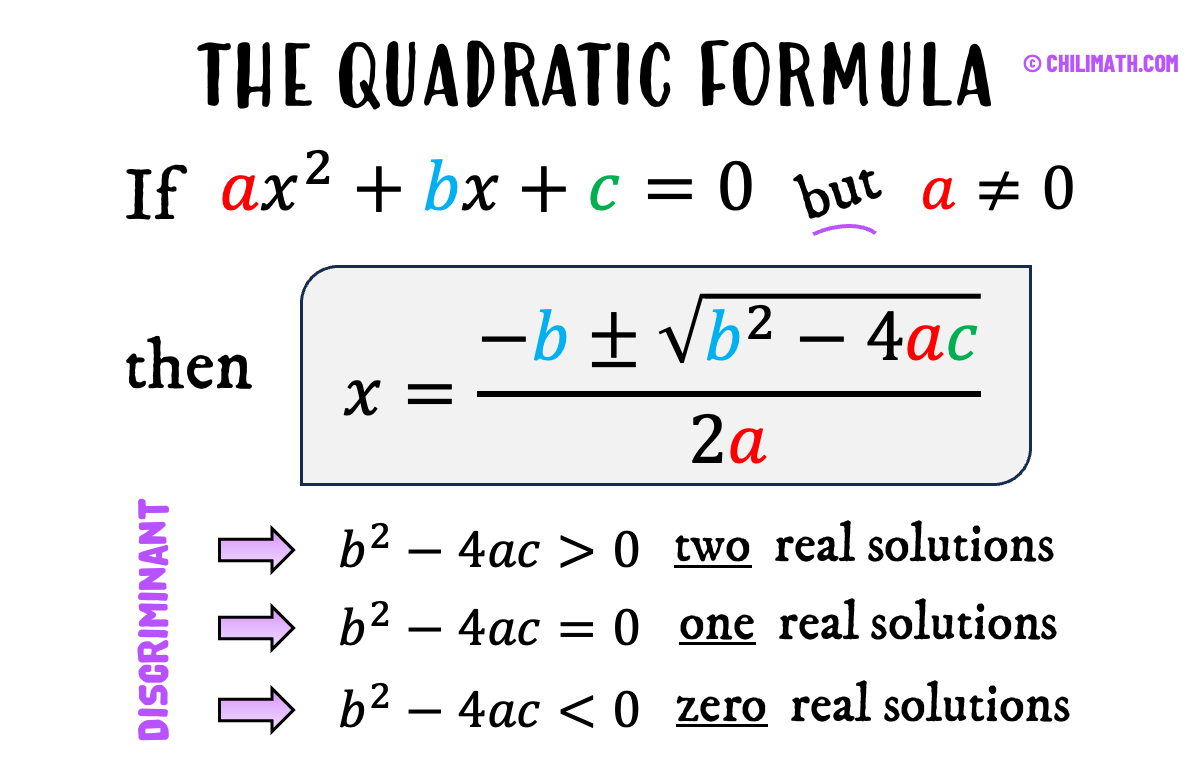
There are a few ways or methods for solving quadratic equations. If the quadratic equation is not easily solvable by the factoring method, we resort to using either completing the square or the quadratic formula.
So, the quadratic formula is a guaranteed or surefire way of solving quadratic equations. That means all quadratic equations can be solved by the quadratic formula.
With that said, if we are given a quadratic equation of the form
[latex]\large{ax^2+bx+c=0}[/latex]
where [latex]a[/latex], [latex]b[/latex], and [latex]c[/latex] are real numbers but [latex]a[/latex] does not equal to zero [latex]a \ne 0[/latex]; and [latex]x[/latex] is the unknown variable, we simply take the values of [latex]a[/latex], [latex]b[/latex], and [latex]c[/latex], plug them into the quadratic formula, then simplify to find the answers. The answers to the quadratic equations are called solutions, zeros, or roots.
But before we can apply the quadratic formula, we need to make sure that the quadratic equation is in the standard form. A quadratic equation is expressed in standard form if all the variables and coefficients are found on one side of the equation, and the opposite across the equal symbol is just zero. That is, if possible, we rewrite and rearrange any equation into the form [latex]\color{red}ax^2+bx+c=0[/latex]. The word quadratic came from the Latin word “quadratus” which means “square”. In algebra, the word square denotes multiplying a number or a variable by itself. Notice that the highest exponent of the variable [latex]x[/latex] in a quadratic equation is 2 ([latex]x[/latex] raised to the 2nd power).
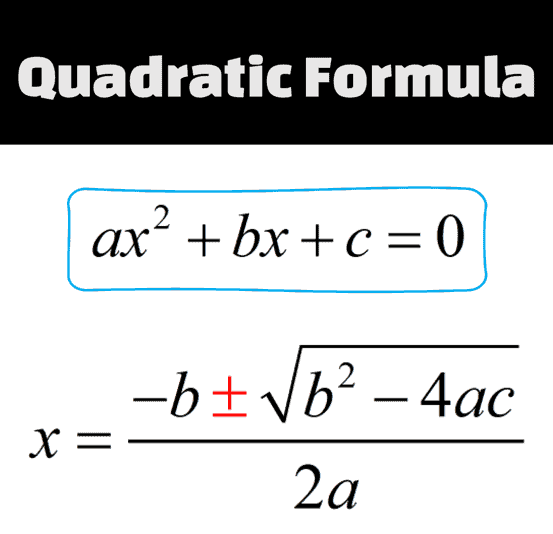
Note that in the quadratic formula above, the plus or minus symbol [latex]\color{red}\large{ \pm}[/latex] is present, implying that we must consider two cases when solving for the solutions.
The two cases of the quadratic formula are as follows:
Case 1: Using the plus symbol [latex]\color{red}+[/latex]
\begin{align*} {x_1} = {{ – b {\color{red}\,+\,} \sqrt {{b^2} – 4ac} } \over {2a}} \end{align*}Case 2: Using the minus symbol [latex]\color{red}-[/latex]
\begin{align*} {x_2} = {{ – b {\color{red}\,-\,} \sqrt {{b^2} – 4ac} } \over {2a}} \end{align*}Discriminant of the Quadratic Formula
The discriminant is the part of the quadratic formula that is inside the square root. For emphasis, it is just the expression [latex]\color{red}{b^2-4ac}[/latex] excluding the radical symbol.
[latex]\LARGE{x = {{ – b \,\pm\, \sqrt {{\color{red}{b^2} – 4ac}} } \over {2a}}}[/latex]
The discriminant of the quadratic formula provides a very useful information regarding the nature of the solutions. In fact, it can determine both the number and types of solutions for a quadratic equation.
In addition, when dealing with discriminant we don’t really care how big or small the number is. Instead, we are just interested if it is positive, zero, or negative.
- If the discriminant is positive [latex]\color{red}\large{+}[/latex], then the quadratic equation has two distinct real solutions.
- If the discriminant is zero [latex]\color{red}\large{0}[/latex], then the quadratic equation has exactly one real solution.
- If the discriminant is negative [latex]\color{red}\large{-}[/latex], then the quadratic equation has two complex solutions, therefore no real solution
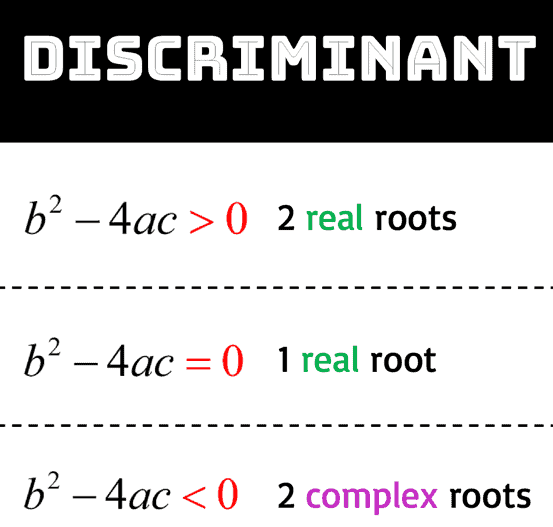
Examples of Using the Quadratic Formula
Example 1: Solve [latex]{x^2} + 4x – 12 = 0[/latex] using the Quadratic Formula.
This equation can easily be solved by factoring method. But for the sake of this lesson, we are asked to solve it using the quadratic formula.
The equation is already in the standard form. The values of [latex]a[/latex], [latex]b[/latex], and [latex]c[/latex] can be readily identified.
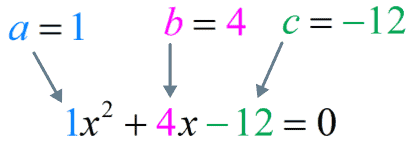
Plug them into the formula then simplify.
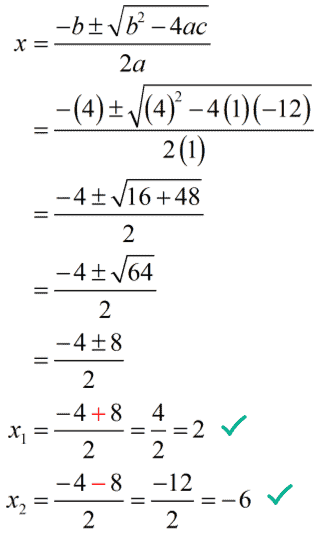
The solutions are [latex]2[/latex] and [latex]-6[/latex].
Let’s graph [latex]f\left( x \right) = {x^2} + 4x – 12[/latex] and see what we get.
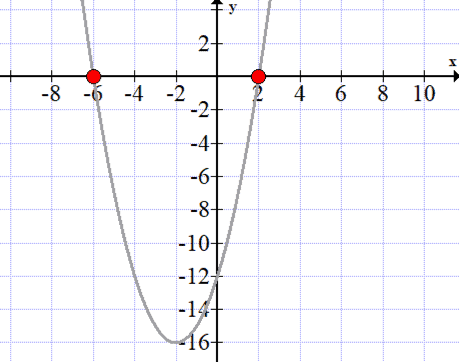
As you can see, the graph crosses or intersects the x-axis at [latex]-6[/latex] and [latex]2[/latex]. The x-intercepts of the parabola match with the solutions that we have computed using the quadratic formula.
Calculator check!
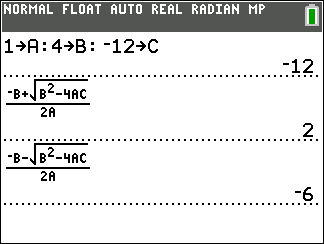
It’s awesome to see that the calculator verifies our answers!
Example 2: Solve [latex]3{x^2} – 17x + 3 = – 7[/latex] using the Quadratic Formula.
The right-hand side of the equation is not completely zero. There is the number [latex]-7[/latex] hanging in there. We can eliminate it by adding [latex]7[/latex] to both sides of the equation since [latex]-7+7=0[/latex].
[latex]3{x^2} – 17x + 3 {\color{red}+ 7} = – 7 {\color{red}+ 7}[/latex]
[latex]3{x^2} – 17x + 10 = 0[/latex]
Clearly, the quadratic equation is now in the standard form. Before we solve it, let’s check out its discriminant to see what kind of solutions that we are going to get.
From [latex]3{x^2} – 17x + 10 = 0[/latex]
[latex]a = 3[/latex]
[latex]b = -17[/latex]
[latex]c = 10[/latex]
The discriminant is [latex]b^2-4ac[/latex], thus
[latex]{b^2} – 4ac = {\left( { – 17} \right)^2} – 4\left( 3 \right)\left( {10} \right)[/latex]
[latex] = 289 – 120[/latex]
[latex]= 169[/latex]
Since the discriminant is positive, we will have two [latex]2[/latex] real solutions or roots.
Let’s proceed with solving the quadratic equation. Identify the values of [latex]a[/latex], [latex]b[/latex], and [latex]c[/latex] from the equation.
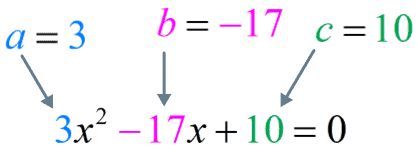
Substitute the values into the quadratic formula then simplify.
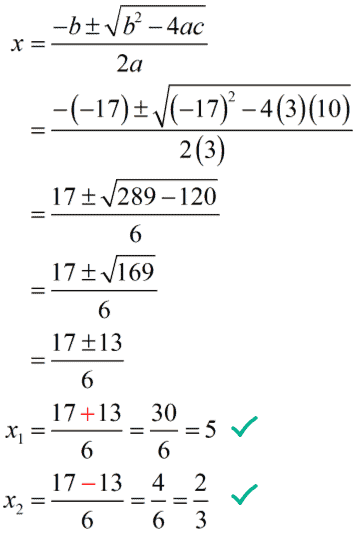
The solutions are [latex]5[/latex] and [latex]\Large{{2 \over 3}}[/latex].
The graph of [latex]f\left( x \right) = 3{x^2} – 17x + 10[/latex] is show below. Observe that the x-intercepts are the solutions to the quadratic equation.
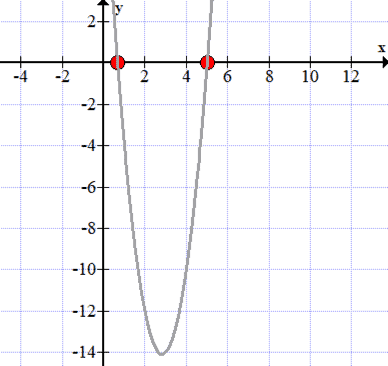
Calculator check!
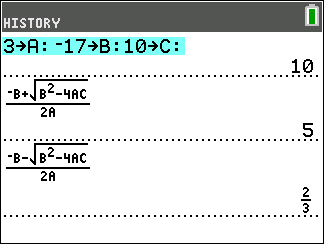
Yes! We got the correct answers as confirmed by the calculator.
Example 3: Use the Quadratic Formula to solve the quadratic equation [latex]4{x^2} – x + 9 = 3x + 8[/latex].
Since either side of the equation is not zero, it means that the equation is not written in standard form. Let’s move everything to the left side by making the right side equal to zero. Subtract both sides by [latex]8[/latex]. Then, we follow that by subtracting both sides of the equation by [latex]3x[/latex]. That should do the trick! The right-hand side must me zero now.
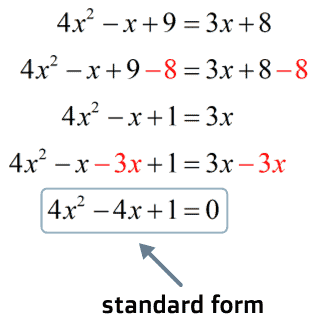
From [latex]4{x^2} – 4x + 1 = 0[/latex], we have the values [latex]a=4[/latex], [latex]b=-4[/latex], and [latex]c=1[/latex].
Calculating the discriminant, we get
[latex]{b^2} – 4ac = {\left( { – 4} \right)^2} – 4\left( 4 \right)\left( 1 \right)[/latex]
[latex] = 16 – 16[/latex]
[latex] = 0[/latex]
Since the discriminant is equal to [latex]0[/latex], the quadratic equation has one [latex]\color{red}1[/latex] real solution.
Let’s check if indeed the quadratic equation has one real root.
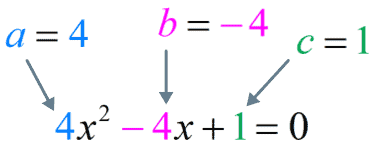
Plug in the values of [latex]a[/latex], [latex]b[/latex], and [latex]c[/latex] into the quadratic formula then simplify.
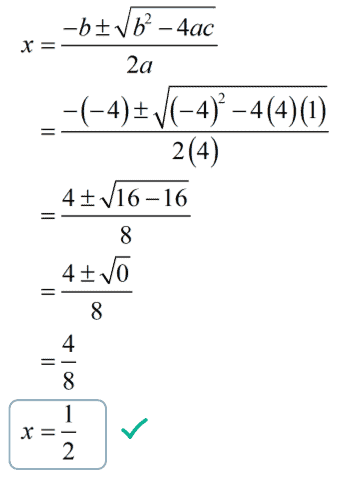
The solution is [latex]\Large{1 \over 2}[/latex]. Yes, there is only one real number solution as predicted by the discriminant.
This is the graph of [latex]f\left( x \right) = 4{x^2} – 4x + 1[/latex]. Notice, the graph does NOT cross or intersect the x-axis at [latex]\large{1 \over 2}[/latex]. Instead, it only touches it at precisely one point!
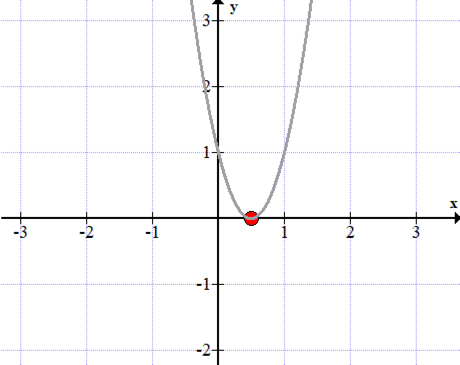
Calculator check!
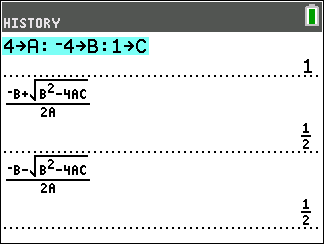
That’s right! As verified by the calculator, there is only one solution which is [latex]\Large {1 \over 2}[/latex].
Example 4: Use the Quadratic Formula to solve the quadratic equation [latex]3{x^2} – 11x + 4 = 2{x^2} – 5x[/latex].
We can transform the quadratic equation into the standard form by adding [latex]5x[/latex] to both sides of the equation then subtracting by [latex]2x^2[/latex].
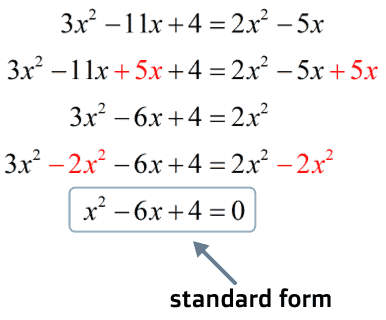
Determine the values of [latex]a[/latex], [latex]b[/latex], and [latex]c[/latex] from the standard form of the quadratic equation.
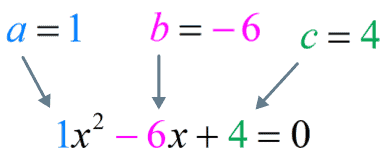
Substitute the values into the formula then simplify.

The solutions are [latex]3 + \sqrt 5 [/latex] and [latex]3 – \sqrt 5 [/latex]. Notice that the roots are irrational numbers.
Here’s the graph of [latex]f\left( x \right) = {x^2} – 6x + 4[/latex]. The x-intercepts are the solutions to the given quadratic equation.
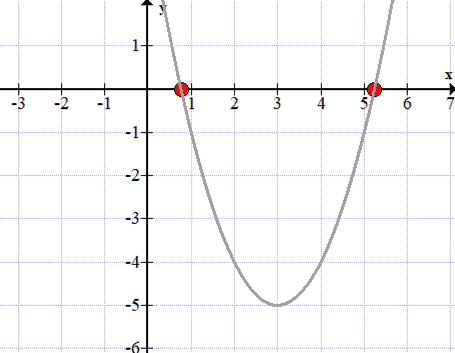
Calculator check!
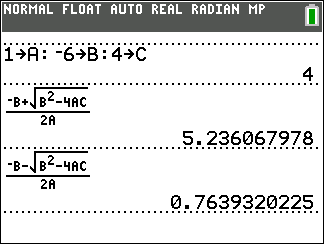
Indeed, the calculator confirms our answers since
[latex]{x_1} = 3 + \sqrt 5 \approx 5.236068[/latex]
and
[latex]{x_2} = 3 – \sqrt 5 \approx 0.763932[/latex]
Example 5: Solve [latex]5{x^2} + 3x + 4 = 4{x^2} + 7x – 9[/latex] using the Quadratic Formula.
The quadratic equation is a mess. We need to rewrite it in standard form. We can do that by adding both sides by [latex]9[/latex]. Next, subtract both sides by [latex]7x[/latex]. Finally, subtract both sides by [latex]4{x^2}[/latex].
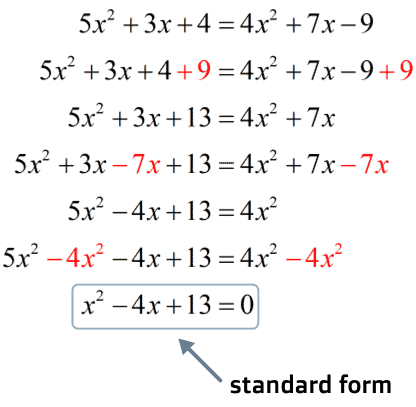
From the standard form [latex]{x^2} – 4x + 13 = 0[/latex], the values of [latex]a[/latex], [latex]b[/latex], and [latex]c[/latex] are as follows.
[latex]\large{a = 1}[/latex]
[latex]\large{b = -4}[/latex]
[latex]\large{c = 13}[/latex]
Calculating the discriminant
[latex]\large{{b^2} – 4ac = {\left( { – 4} \right)^2} – 4\left( 1 \right)\left( 13 \right)}[/latex]
[latex]\large{ = 16 – 52}[/latex]
[latex]\large{ = – 36}[/latex]
Since the discriminant is negative, the quadratic equation will have two complex solutions.
Now we solve the equation using the formula.
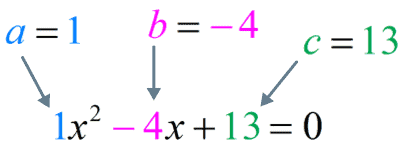
Substitute then simplify.

The complex solutions are [latex]2 + 3i[/latex] and [latex]2 – 3i[/latex].
Since the solutions are complex numbers, the graph of the parabola does not intersect or touch the x-axis. It also means that the graph does not have x-intercepts as you can see in the graph below.

You may also be interested in these related math lessons or tutorials:
Derivation of the Quadratic Formula
